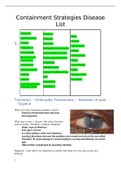Samenvatting
Summary Complete disease list for Containment Strategies
- Instelling
- Vrije Universiteit Amsterdam (VU)
In this document, all diseases that you need to study for the exam are summarized. Each disease has info on what is is (virus/bacterium/parasite), what it causes, diagnosis, transmission, incubation period/period of communicability, occurrence and distribution, prevention and control, treatment and...
[Meer zien]





